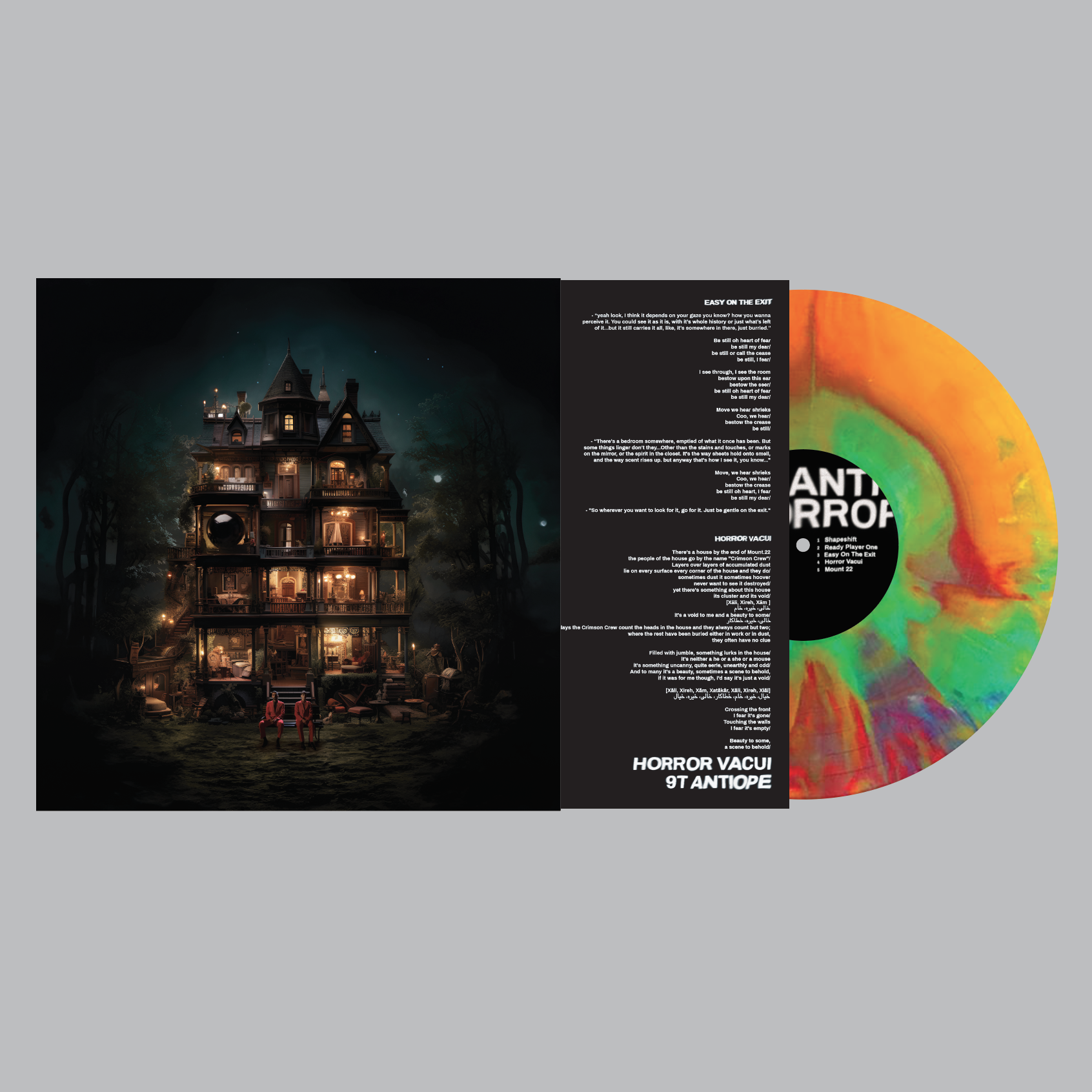



All physical media comes with a digital download card.
9T Antiope Horror Vacui
Picture this: there's a big house at the end of the street. When you walk past it, you can't tell if it's full or empty. Its two caretakers—who, to add to the uncanniness, wear crimson suits—clean the house, inspect it, and carry out headcounts. Sometimes they only count themselves. Sometimes they count hundreds of people. They don't know why this is the case, why the house has so many rooms and stories: it’s not their job to know. One day, as you walk past, a void enters and the house explodes. What happens to what's inside? What impact does it have on your memory? This is the story of 9T Antiope’s Horror Vacui, a concept album that develops the band’s cinematic work into new reaches, exploring what sounds have been and what they’ll become, and the nature of memory, dementia, and decay.
On past albums, Nima Aghiani and Sara Bigdeli Shamloo gave voice to the challenges of their lives as Iranian expatriates, but here they expand the scope of their music, turning the idea of horror vacui on its head. Conceptually, horror vacui hinges on a resistance to letting empty spaces remain empty. Is it part of human nature or nature itself? If, as Aristotle is summarized, “nature abhors a vacuum,” why?
9T Antiope drill into the fears of horror vacui while building a dynamic world that seems to exist outside of the bounds of time and place. “For people like us,” the band says, “living in the in-between of two worlds we’ve lived in, the ongoing search for a relation between the world one used to know and the new world—at times, neither the origin nor the destination exist as a whole. New and old sounds, colors, textures and spaces overlap. Then the differences emerge, drag the two spaces apart,” and create thresholds. The title track illustrates these thresholds most prominently with the kh sound in Farsi, where vastly different meanings result from slight changes in pronunciation, language alone struggling to convey its depths. Other songs directly call out the complications of memory (“Let me forget…I no longer want to hear or smell or see”), flashbacks, or the difficulty of dementia and age-related decline.
Relying on a sparse palette of octave mandolin, violin, octave violin, synthesizer, and vocals, 9T Antiope has honed their attention to the relationship between sound and language. As the physical details of bodies and experience present themselves as ruptures, the music shows the difficulty of accepting the ruptures and the process that creates them. As Shamloo sings on album opener “Shapeshift”: “No more, no more, no more feelings/No more, no more, no more kneeling/To push through, had to stop dreaming/I shift, I go, I shift.” The song expresses the apprehension of watching one’s own world unfold before their eyes, with “the constant emergence of flashbacks and the ongoing fear of forgetting or being forgotten.” This process becomes palpable on the title track, thanks to the dichotomy between Aghiani’s crunching drone, quivering octave violin, and Shamloo’s vocals—spoken, crooned and snarled.
The album walks a line between structure and formlessness, heaviness and softness, contemporary production and deep-rooted Middle Eastern melodies. At bottom, Horror Vacuiuses music and language as tools to confront dualities and acknowledge the space between them. Rather than pretend the fear isn’t there, it says, look, and invites you to look with it.
released July 12, 2023
Music composed and produced by Nima Aghiani
Songs written and performed by Sara Bigdeli Shamloo
Violin, octave Violin and octave mandolin performed by Nima Aghiani
Mixed and mastered by Nima Aghiani
Artwork by Ashkan Noroozkhani
Design by Devin Shaffer
Music composed and produced by Nima Aghiani
Songs written and performed by Sara Bigdeli Shamloo
Violin, octave Violin and octave mandolin performed by Nima Aghiani
Mixed and mastered by Nima Aghiani
Artwork by Ashkan Noroozkhani
Design by Devin Shaffer

